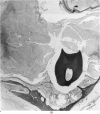Abstract
In rhesus macaques (Macaca mulatta), consumption of food containing commercial polychlorinated biphenyl (PCB) mixtures, some pure polychlorobiphenyl congeners, 2,3,7,8- tetrachlorodibenzo-p-dioxin (TCDD), and 2,3,7,8-tetrachlorodibenzofuran (TCDF) caused the same clinical toxic manifestations and histopathologic lesions, although the potencies of the toxicants covered a range of five orders of magnitude. Recovery from poisoning by 3,4,3',4'-tetrachlorobiphenyl (34TCB) or TCDF was rapid, whereas recovery from poisoning by Aroclor 1242, 3,4,5,3', 4', 5'-hexachlorobiphenyl (345HCB) or TCDD was protracted, if it occurred at all. 34TCB did not appreciably accumulate in body fat, but the level of 345HCB in fat rose steadily during ingestion. In one monkey, 25% of TCDD stored in fat after a single dose was still present after 2 years. Among the symmetrical tetra-and hexachlorobiphenyl isomers tested, subacute oral toxicity could be demonstrated only for those without ortho chlorine substitutions. 34TCB and 345HCB were toxic at dietary levels of less than 1 ppm, but ingestion of food containing 2,5,2',5'- tetrachlorobiphenyl at 5 ppm, or 2,4,5,2',4',5'-, 2,4,6,2',4',6'-, or 2,3,6,2',3',6'-hexachlorobiphenyl at 15 or 65 ppm, caused no discernible deleterious effects. The principal demonstrable histopathological lesions, bone marrow excepted, were metaplasias in some specialized epithelial structures, such as sebaceous glands, nail beds, gastric mucosa, ameloblast, and thymic corpuscles. These changes were interpreted as toxicant-induced, reversible redirection of differentiation. This aberration was wholly reversible. TCDD and 34TCB caused abortions when given in one or a few oral doses early in pregnancy. At the total doses used (1 or 5 micrograms/kg of body weight for TCDD, 3 or 0.6 mg/kg of body weight for 34TCB), maternal toxicity was frequently apparent subsequent to the abortion.
Full text
PDF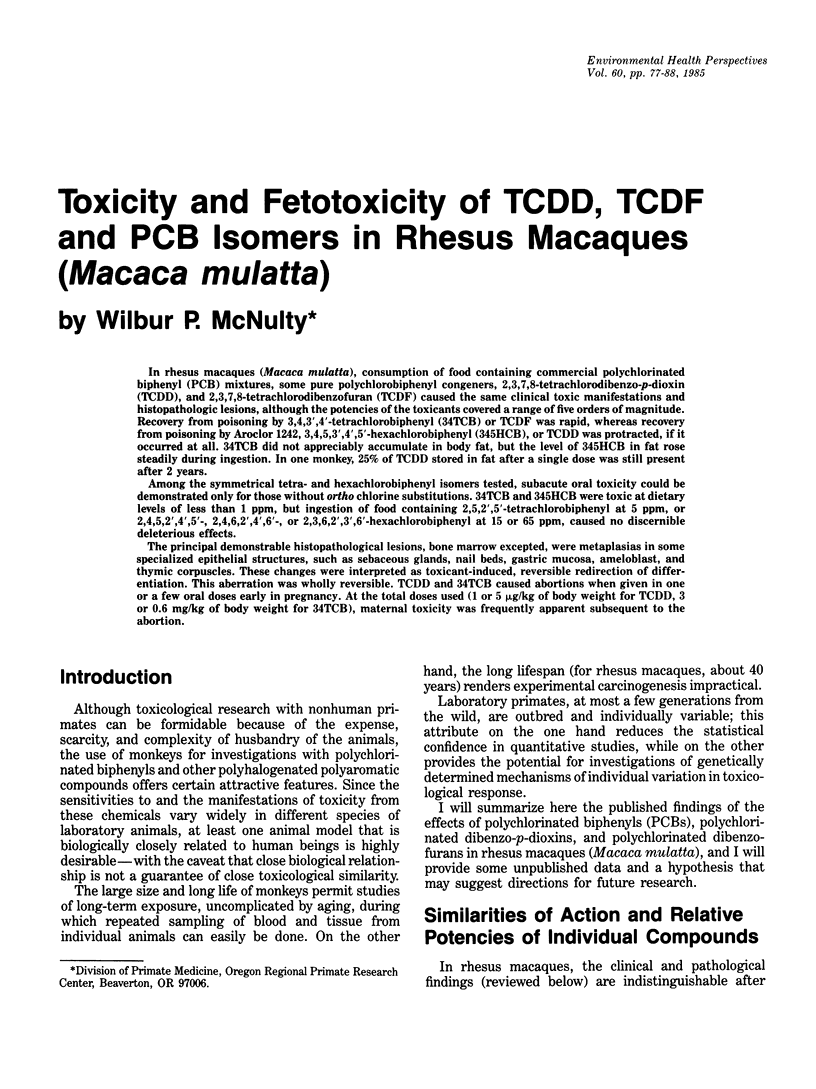
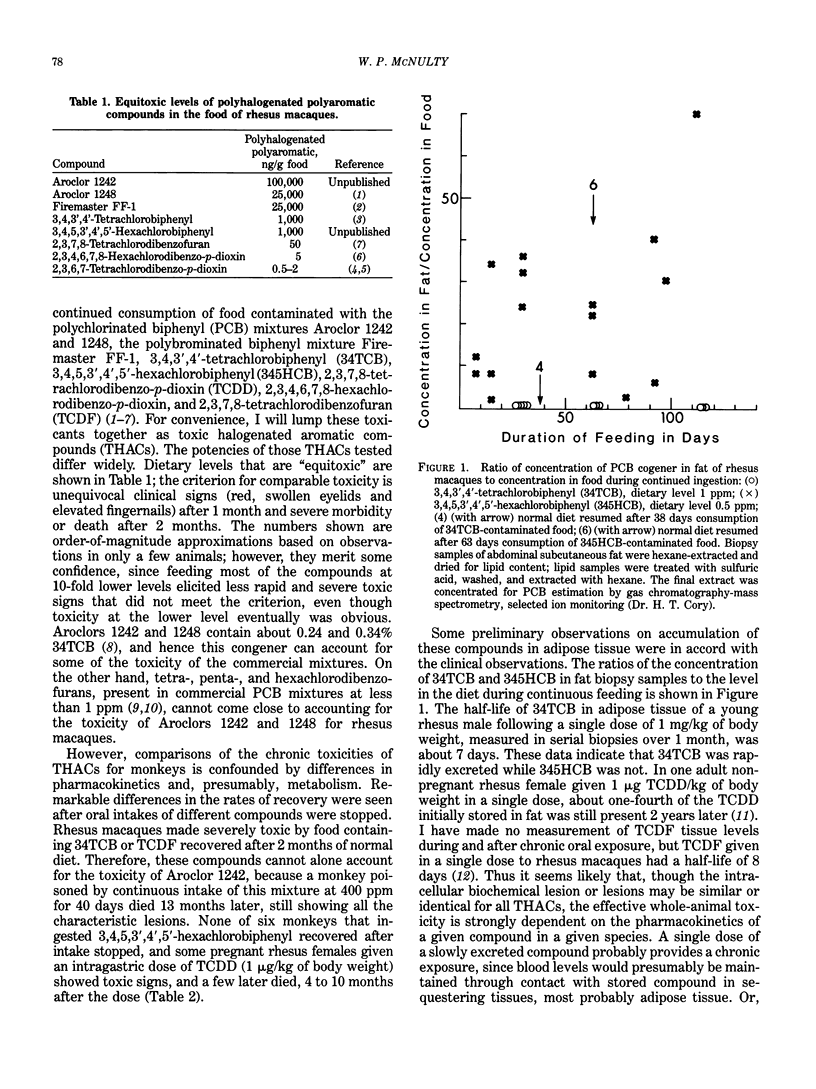
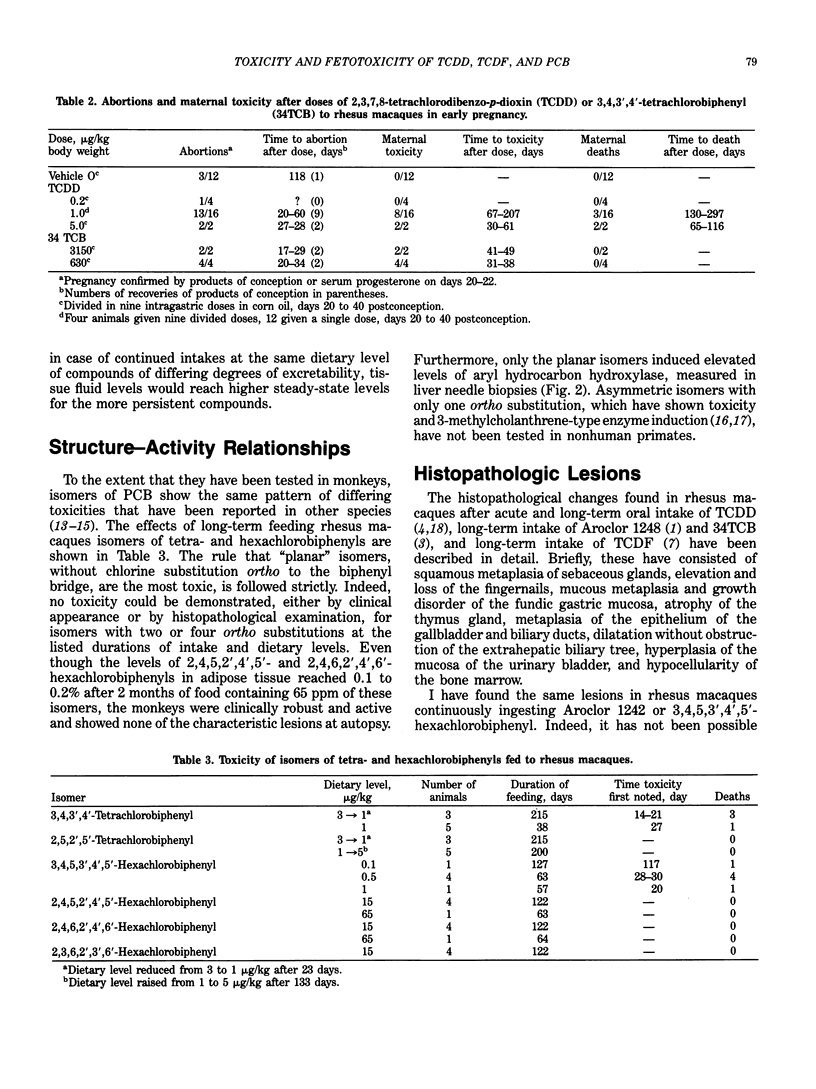
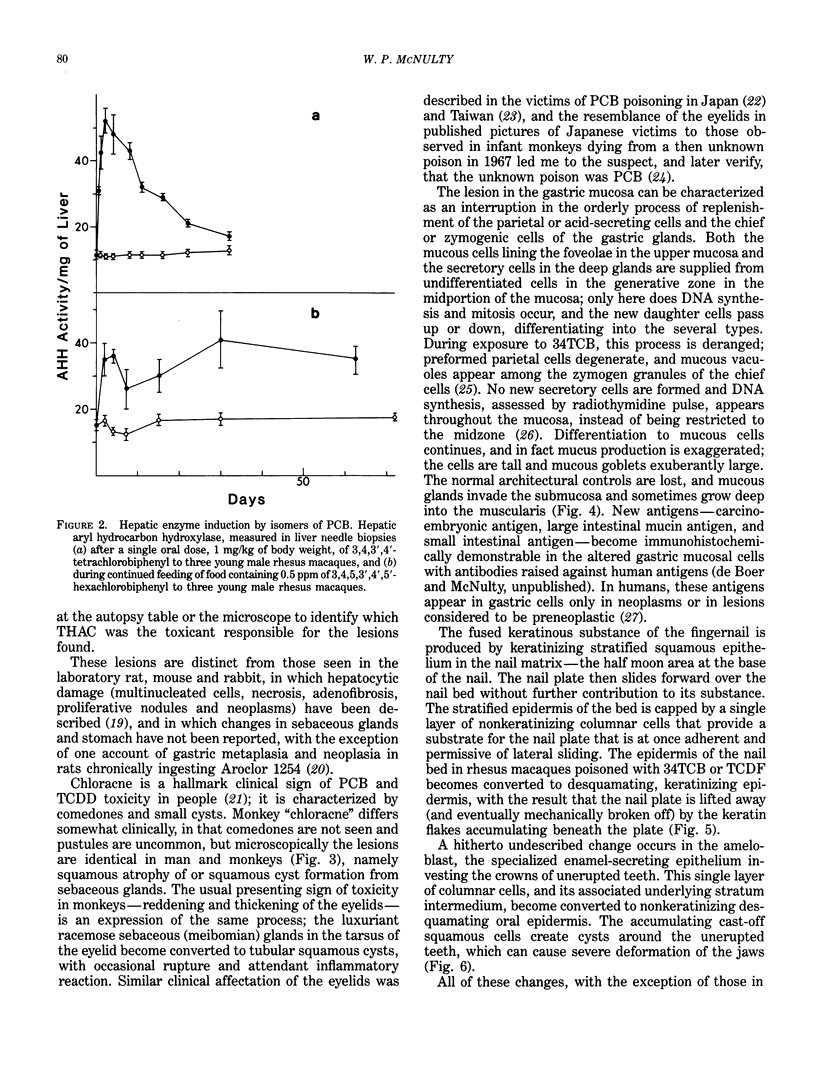
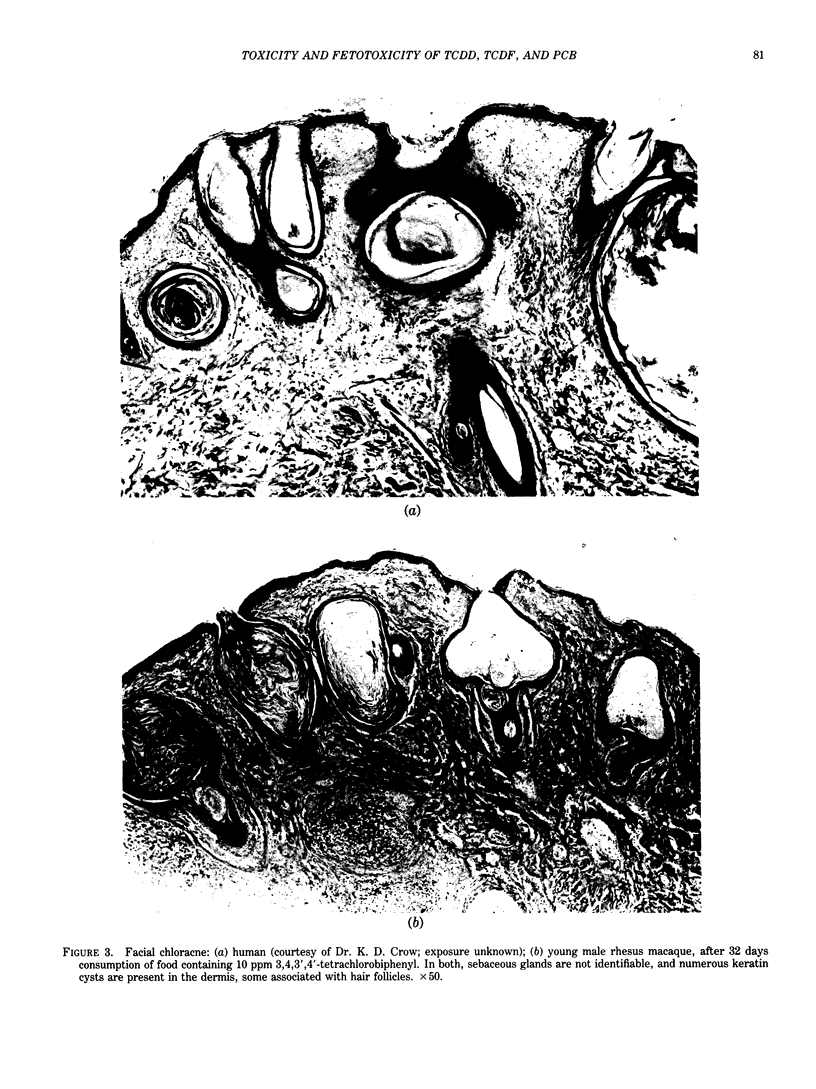
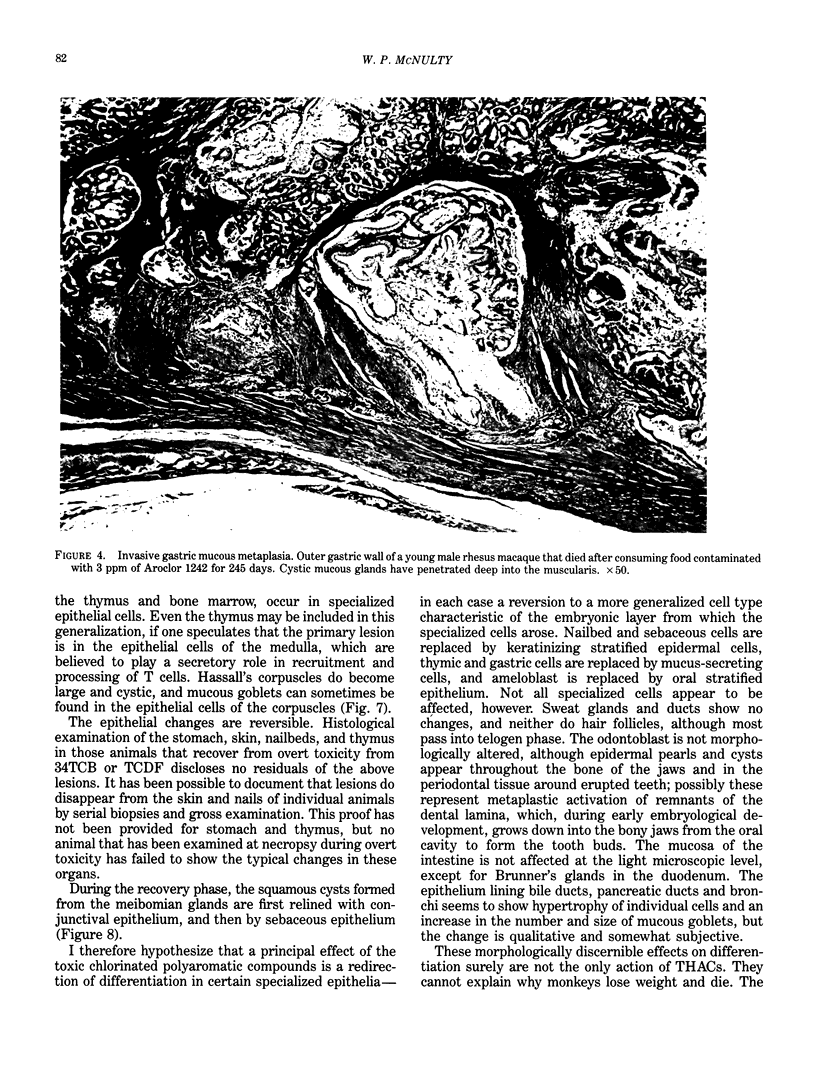
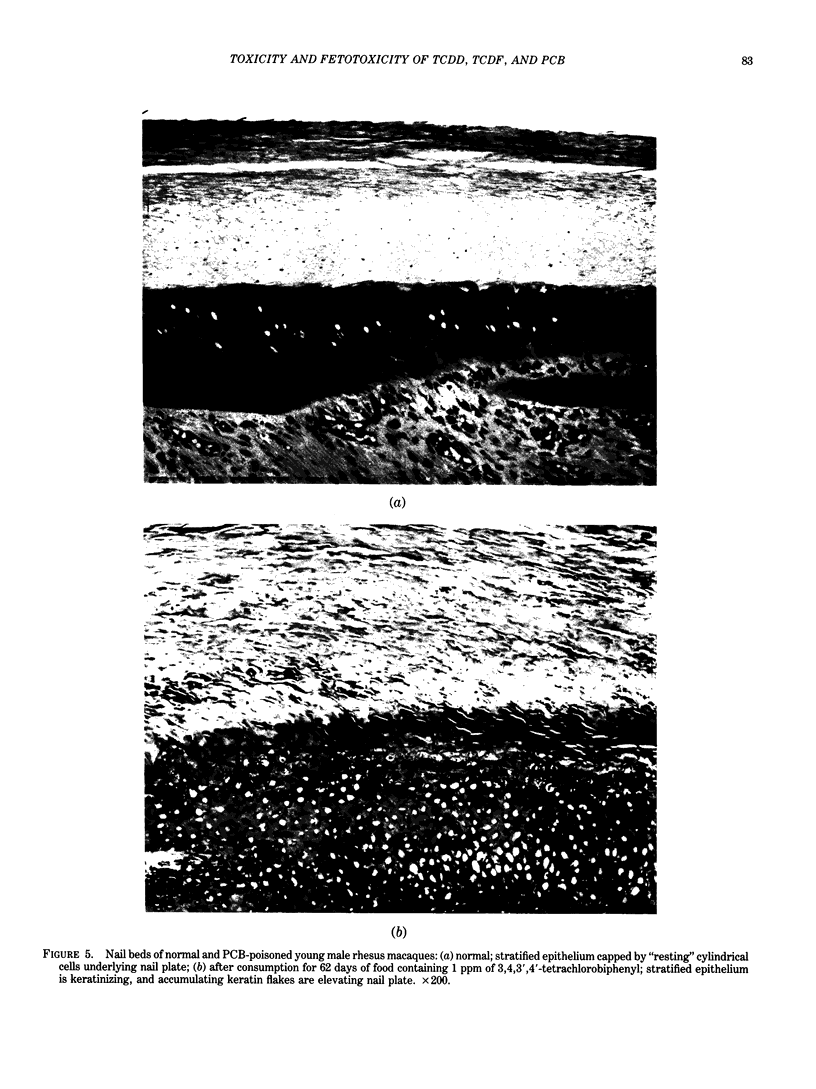
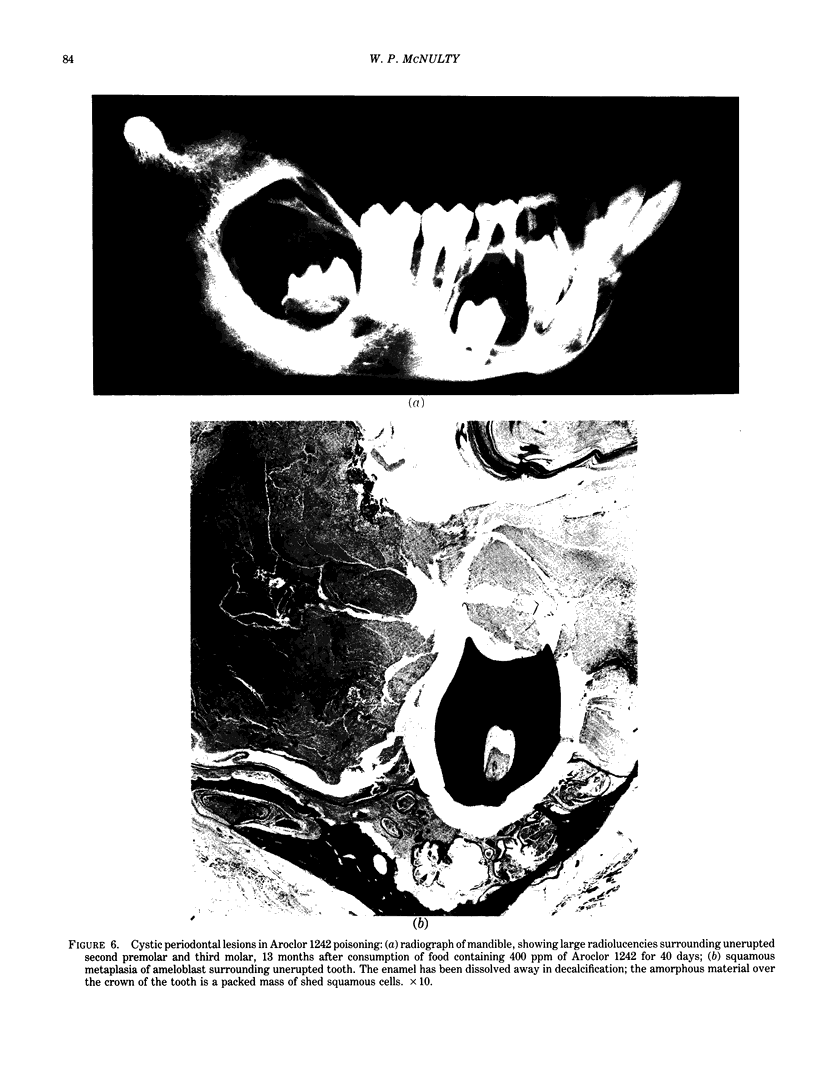
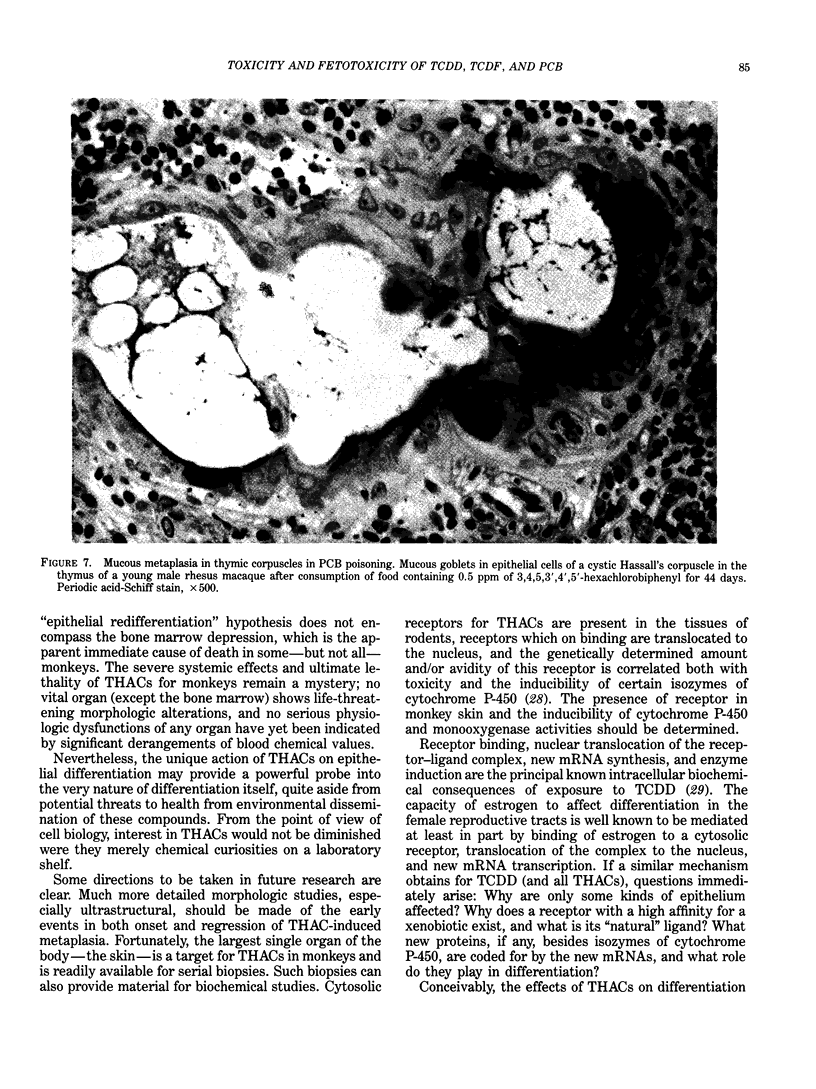
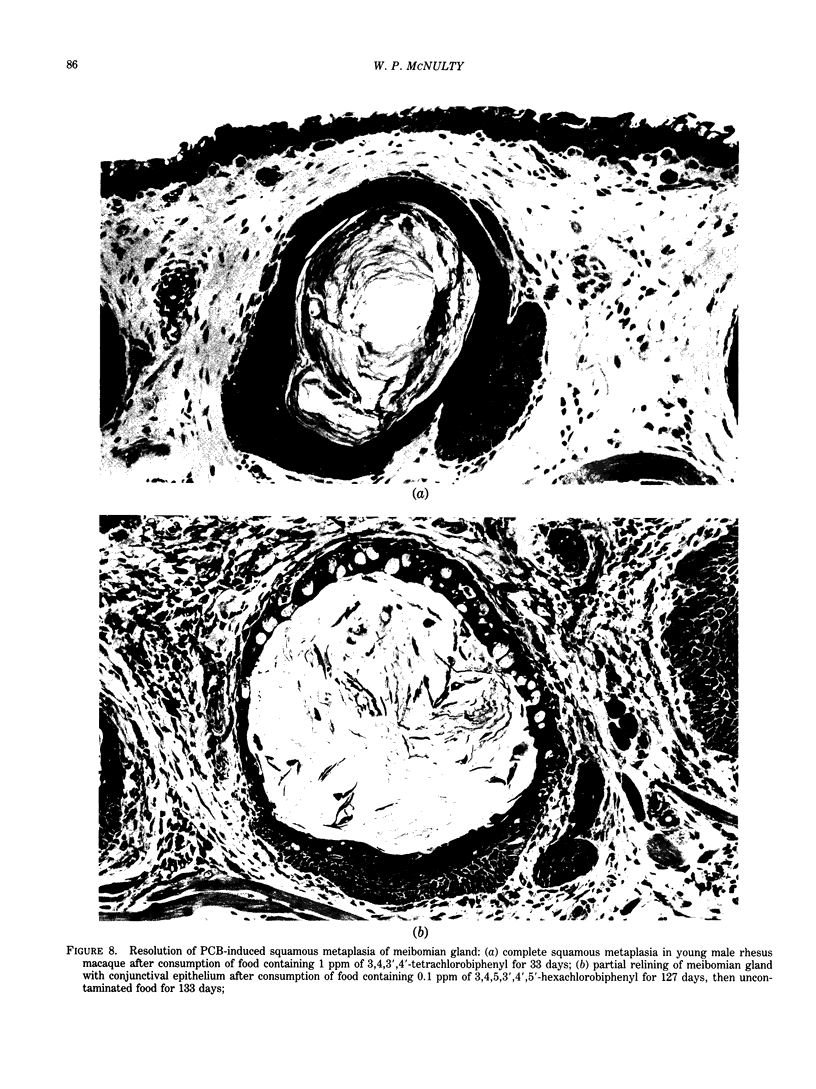
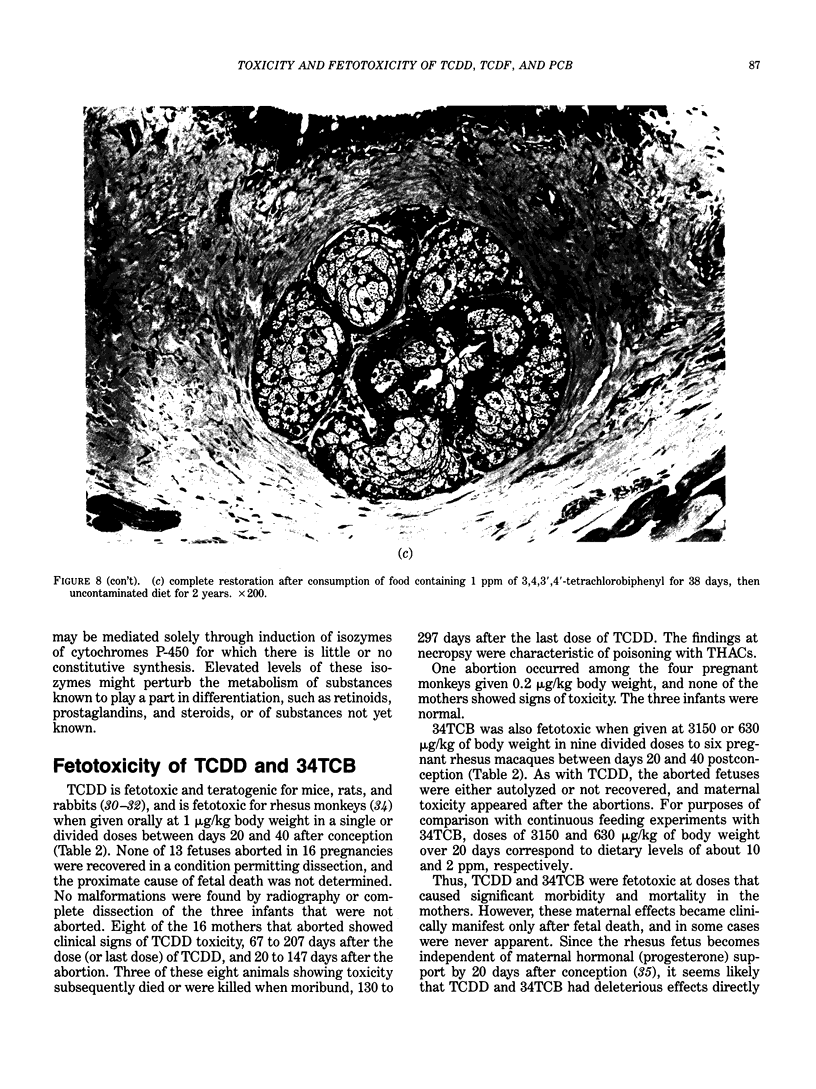
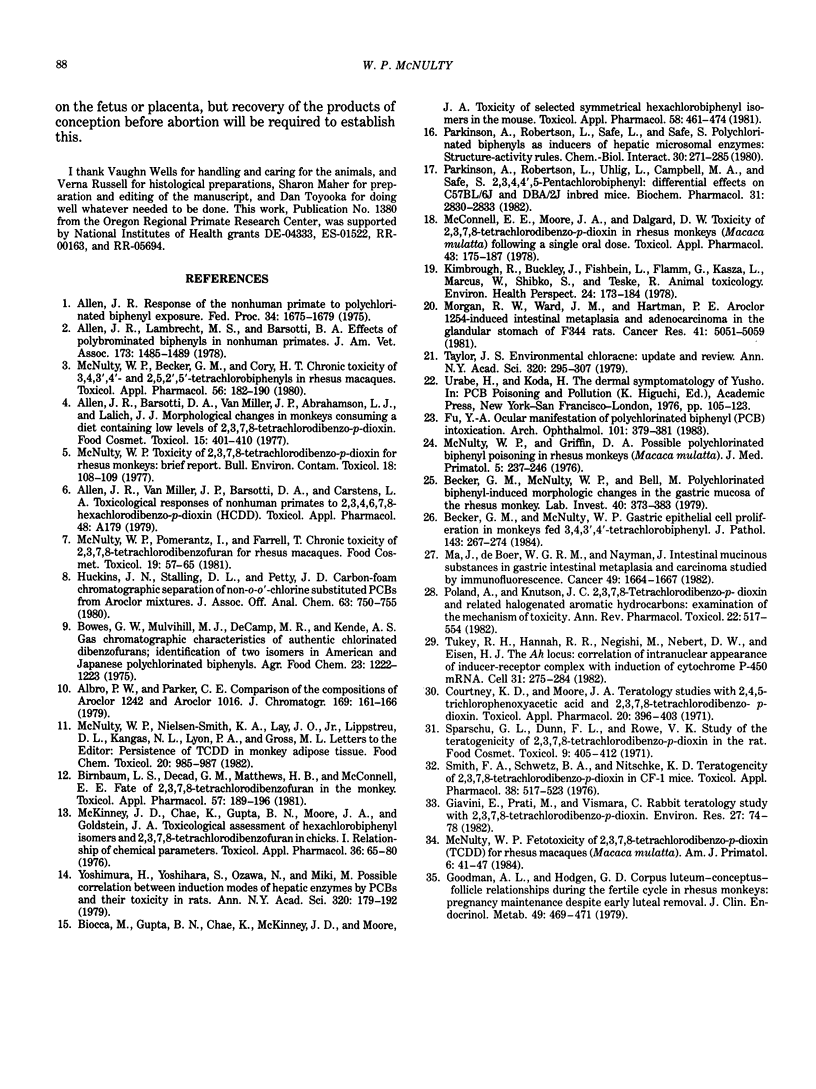
Images in this article
Selected References
These references are in PubMed. This may not be the complete list of references from this article.
- Albro P. W., Parker C. E. Comparison of the compositions of Aroclor 1242 and Aroclor 1016. J Chromatogr. 1979 Feb 1;169:161–166. doi: 10.1016/0021-9673(75)85041-2. [DOI] [PubMed] [Google Scholar]
- Allen J. R., Barsotti D. A., Van Miller J. P., Abrahamson L. J., Lalich J. J. Morphological changes in monkeys consuming a diet containing low levels of 2,3,7,8-tetrachlorodibenzo-p-dioxin. Food Cosmet Toxicol. 1977 Oct;15(5):401–410. doi: 10.1016/s0015-6264(77)80004-7. [DOI] [PubMed] [Google Scholar]
- Allen J. R. Response of the nonhuman primate to polychlorinated biphenyl exposure. Fed Proc. 1975 Jul;34(8):1675–1679. [PubMed] [Google Scholar]
- Becker G. M., McNulty W. P., Bell M. Polychlorinated biphenyl-induced morphologic changes in the gastric mucosa of the rhesus monkey. Lab Invest. 1979 Mar;40(3):373–383. [PubMed] [Google Scholar]
- Becker G. M., McNulty W. P. Gastric epithelial cell proliferation in monkeys fed 3,4,3',4'-tetrachlorobiphenyl. J Pathol. 1984 Aug;143(4):267–274. doi: 10.1002/path.1711430406. [DOI] [PubMed] [Google Scholar]
- Biocca M., Gupta B. N., Chae K., McKinney J. D., Moore J. A. Toxicity of selected symmetrical hexachlorobiphenyl isomers in the mouse. Toxicol Appl Pharmacol. 1981 May;58(3):461–474. doi: 10.1016/0041-008x(81)90099-5. [DOI] [PubMed] [Google Scholar]
- Birnbaum L. S., Decad G. M., Matthews H. B., McConnell E. E. Fate of 2,3,7,8-tetrachlorodibenzofuran in the monkey. Toxicol Appl Pharmacol. 1981 Feb;57(2):189–196. doi: 10.1016/0041-008x(81)90279-9. [DOI] [PubMed] [Google Scholar]
- Bowes G. W., Mulvihill M. J., DeCamp M. R., Kende A. S. Gas chromatographic characteristics of authentic chlorinated dibenzofurans; identification of two isomers in American and Japanese polychlorinated biphenyls. J Agric Food Chem. 1975 Nov-Dec;23(6):1222–1223. doi: 10.1021/jf60202a045. [DOI] [PubMed] [Google Scholar]
- Courtney K. D., Moore J. A. Teratology studies with 2,4,5-trichlorophenoxyacetic acid and 2,3,7,8-tetrachlorodibenzo-p-dioxin. Toxicol Appl Pharmacol. 1971 Nov;20(3):396–403. doi: 10.1016/0041-008x(71)90282-1. [DOI] [PubMed] [Google Scholar]
- Fu Y. A. Ocular manifestation of polychlorinated biphenyl (PCB) intoxication. Its relationship to PCB blood concentration. Arch Ophthalmol. 1983 Mar;101(3):379–381. doi: 10.1001/archopht.1983.01040010379004. [DOI] [PubMed] [Google Scholar]
- Giavini E., Prati M., Vismara C. Rabbit teratology study with 2,3,7,8-tetrachlorodibenzo-p-dioxin. Environ Res. 1982 Feb;27(1):74–78. doi: 10.1016/0013-9351(82)90058-5. [DOI] [PubMed] [Google Scholar]
- Goodman A. L., Hodgen G. D. Corpus luteum--conceptus--follicle relationships during the fertile cycle in rhesus monkeys: pregnancy maintenance despite early luteal removal. J Clin Endocrinol Metab. 1979 Sep;49(3):469–471. doi: 10.1210/jcem-49-3-469. [DOI] [PubMed] [Google Scholar]
- Kimbrough R., Buckley J., Fishbein L., Flamm G., Kasza L., Marcus W., Shibko S., Teske R. Animal toxicology. Environ Health Perspect. 1978 Jun;24:173–185. doi: 10.1289/ehp.7824173. [DOI] [PMC free article] [PubMed] [Google Scholar]
- Ma J., De Boer W. G., Nayman J. Intestinal mucinous substances in gastric intestinal metaplasia and carcinoma studied by immunofluorescence. Cancer. 1982 Apr 15;49(8):1664–1667. doi: 10.1002/1097-0142(19820415)49:8<1664::aid-cncr2820490822>3.0.co;2-o. [DOI] [PubMed] [Google Scholar]
- McConnell E. E., Moore J. A., Dalgard D. W. Toxicity of 2,3,7,8-tetrachlorodibenzo-p-dioxin in rhesus monkeys (Macaca mulatta) following a single oral dose. Toxicol Appl Pharmacol. 1978 Jan;43(1):175–187. doi: 10.1016/s0041-008x(78)80042-8. [DOI] [PubMed] [Google Scholar]
- McKinney J. D., Chae K., Gupta B. N., Moore J. A., Goldstein H. A. Toxicological assessment of hexachlorobiphenyl isomers and 2,3,7,8 tetrachlorodibenzofuran in chicks. I. Relationship of chemical parameters. Toxicol Appl Pharmacol. 1976 Apr;36(1):65–80. doi: 10.1016/0041-008x(76)90027-2. [DOI] [PubMed] [Google Scholar]
- McNulty W. P., Becker G. M., Cory H. T. Chronic toxicity of 3,4,3',4'- and 2,5,2',5'-tetrachlorobiphenyls in rhesus macaques. Toxicol Appl Pharmacol. 1980 Nov;56(2):182–190. doi: 10.1016/0041-008x(80)90288-4. [DOI] [PubMed] [Google Scholar]
- McNulty W. P., Griffin D. A. Possible polychlorinated biphenyl poisoning in rhesus monkeys (Macaca mulatta) J Med Primatol. 1976;5(4):237–246. doi: 10.1159/000459954. [DOI] [PubMed] [Google Scholar]
- McNulty W. P., Pomerantz I., Farrell T. Chronic toxicity of 2,3,7,8-tetrachlorodibenzofuran for rhesus macaques. Food Cosmet Toxicol. 1981 Feb;19(1):57–65. doi: 10.1016/0015-6264(81)90304-7. [DOI] [PubMed] [Google Scholar]
- McNulty W. P. Toxicity of 2,3,7,8-tetrachlorodibenzo-p-diozin for rhesus monkeys: brief report. Bull Environ Contam Toxicol. 1977 Jul;18(1):108–109. doi: 10.1007/BF01686315. [DOI] [PubMed] [Google Scholar]
- Morgan R. W., Ward J. M., Hartman P. E. Aroclor 1254-induced intestinal metaplasia and adenocarcinoma in the glandular stomach of F344 rats. Cancer Res. 1981 Dec;41(12 Pt 1):5052–5059. [PubMed] [Google Scholar]
- Parkinson A., Robertson L., Safe L., Safe S. Polychlorinated biphenyls as inducers of hepatic microsomal enzymes: structure-activity rules. Chem Biol Interact. 1980 Jun;30(3):271–285. doi: 10.1016/0009-2797(80)90050-2. [DOI] [PubMed] [Google Scholar]
- Parkinson A., Robertson L., Uhlig L., Campbell M. A., Safe S. 2,3,4,4'-Pentachlorobiphenyl: differential effects on C57BL/6J and DBA/2J inbred mice. Biochem Pharmacol. 1982 Sep 1;31(17):2830–2833. doi: 10.1016/0006-2952(82)90143-5. [DOI] [PubMed] [Google Scholar]
- Poland A., Knutson J. C. 2,3,7,8-tetrachlorodibenzo-p-dioxin and related halogenated aromatic hydrocarbons: examination of the mechanism of toxicity. Annu Rev Pharmacol Toxicol. 1982;22:517–554. doi: 10.1146/annurev.pa.22.040182.002505. [DOI] [PubMed] [Google Scholar]
- Smith F. A., Schwetz B. A., Nitschke K. D. Teratogenicity of 2,3,7,8-tetrachlorodibenzo-p-dioxin in CF-1 mice. Toxicol Appl Pharmacol. 1976 Dec;38(3):517–523. doi: 10.1016/0041-008x(76)90183-6. [DOI] [PubMed] [Google Scholar]
- Sparschu G. L., Dunn F. L., Rowe V. K. Study of the teratogenicity of 2,3,7,8-tetrachlorodibenzo-p-dioxin in the rat. Food Cosmet Toxicol. 1971 Jun;9(3):405–412. doi: 10.1016/0015-6264(71)90045-9. [DOI] [PubMed] [Google Scholar]
- Taylor J. S. Environmental chloracne: update and overview. Ann N Y Acad Sci. 1979 May 31;320:295–307. [PubMed] [Google Scholar]
- Tukey R. H., Hannah R. R., Negishi M., Nebert D. W., Eisen H. J. The Ah locus: correlation of intranuclear appearance of inducer-receptor complex with induction of cytochrome P1-450 mRNA. Cell. 1982 Nov;31(1):275–284. doi: 10.1016/0092-8674(82)90427-5. [DOI] [PubMed] [Google Scholar]
- Yoshimura H., Yoshihara S., Ozawa N., Miki M. Possible correlation between induction modes of hepatic enzymes by PCBs and their toxicity in rats. Ann N Y Acad Sci. 1979 May 31;320:179–192. doi: 10.1111/j.1749-6632.1979.tb56600.x. [DOI] [PubMed] [Google Scholar]









